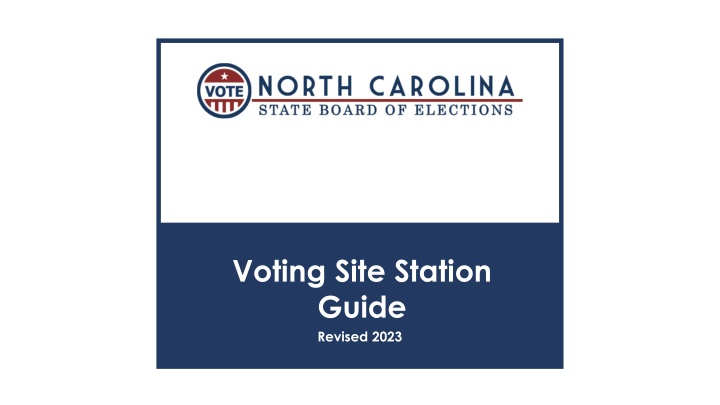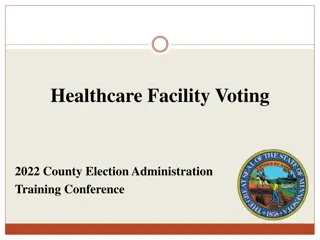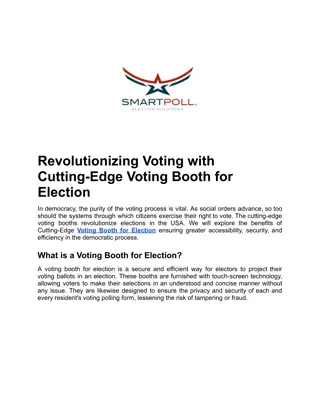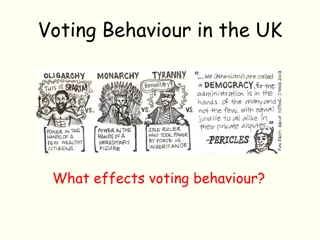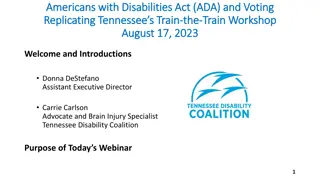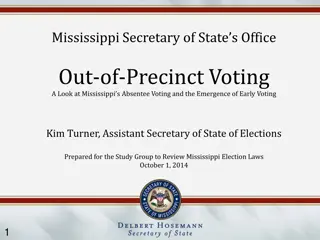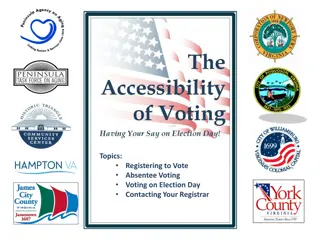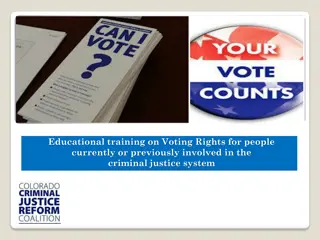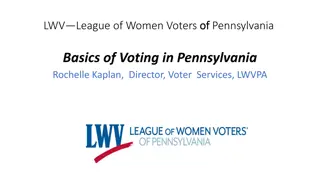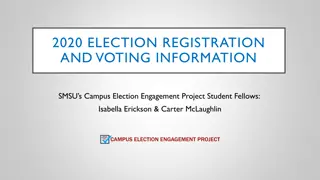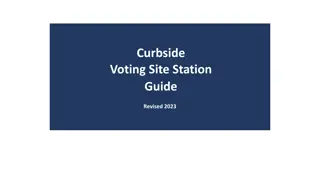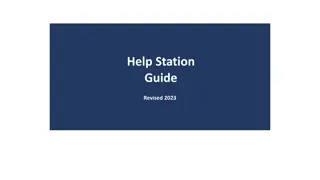Revised 2023 Voting Site Station Guide
Revised for 2023, the Voting Site Station Guide provides detailed check-in procedures for voters, including voter greeting, photo ID review, eligibility determination, and voting authorization. It outlines steps for assisting voters and ensures a smooth voting process. The guide emphasizes the importance of voter assistance and eligibility verification in a clear and straightforward manner.
Download Presentation

Please find below an Image/Link to download the presentation.
The content on the website is provided AS IS for your information and personal use only. It may not be sold, licensed, or shared on other websites without obtaining consent from the author.If you encounter any issues during the download, it is possible that the publisher has removed the file from their server.
You are allowed to download the files provided on this website for personal or commercial use, subject to the condition that they are used lawfully. All files are the property of their respective owners.
The content on the website is provided AS IS for your information and personal use only. It may not be sold, licensed, or shared on other websites without obtaining consent from the author.
E N D
Presentation Transcript
Voting Site Station Guide Revised 2023
Check-in Procedures 1 Voter Greeting 2 Initial Photo ID Review 3 Examination of Photo and Name on Photo ID 4 Voter Status Review 5 Address Review 6 Party Affiliation Review-In Partisan Primaries Only 7 Determination of Eligibility and Voting Authorization Check-in Station Steps
Step 1: Voter Greeting Determine if the voter requires assistance Ask for the voter s name Ask for the voter to show a photo ID
Determine if the voter requires assistance If a voter is in need of assistance, it must be requested. If a voter is accompanied when presenting to vote, an election official must determine if the voter wants assistance from that person. The voter may also ask for assistance from an election official. Who may assist a voter? A voter is entitled to assistance from a near relative: spouse, parent, child, brother, sister, grandparent, grandchild, stepparent, stepchild, mother-in-law, father-in-law, son-in-law, daughter-in-law Who may receive voter assistance? Disabled voters may receive the following forms of assistance from anyone except an agent of their employer or union representative: entering the voting booth due to physical disability or blindness assistance in marking the ballot due to physical disability, illiteracy, or blindness Children under the age of 18 may accompany the voter. ADA requires that service animals are allowed in any polling place. Check-in Station| 1 Step 1: Voter Greeting
Election officials should follow the script below to determine if a voter is entitled to assistance: 1. Ask the voter: Is this person here to assist you? a. If YES, go to question 2. b. If NO, instruct the person that they need to wait outside the voting enclosure. Ask the voter: Is this person a near relative? Refer to explanation of who can assist a voter. a. If YES, the voter may receive assistance. No further information is needed. b. If NO, go to question 3. Say: A voter who needs assistance because the voter is blind, disabled, or unable to read, speak, or write English may receive assistance from a person of the voter s choice. Do you need assistance for one of these reasons? a. If YES, go to #4. b. If NO, the voter is not entitled to receive assistance from someone who is not a near relative. If requested by the voter, an assistant, judge, or chief judge may assist the voter. Ask the voter: Is this person your employer, employer s agent, officer of your union, or agent of your union? a. If YES, the person may not assist the voter. The voter may select someone else to assist him or her. If requested by the voter, an assistant, judge, or chief judge may assist 2. 3. 4. entering the voting booth due to physical disability or blindness, assistance in marking the ballot due to physical disability, illiteracy, or blindness the voter. If NO, the voter may receive assistance. No further information is needed. a. Step 1: Voter Greeting Check-in Station | 2
Ask for the Voter's Name The voter's statement of address must be heard by the election official. If the voter's statement is difficult to hear or discern, an election official may ask the voter to repeat the name more slowly or loudly, or to spell any portion of the name. If a person is unable to state their name because of an impairment, the election official may make reasonable accommodations including asking the voter to write their name. The voter may be able but unwilling to state their name. The official will explain that the law requires voters to state their name aloud. If the voter continues to refuse to cooperate with the election official at the check-in station, the official will arrange for the voter to speak with the Chief Judge.
Ask for the voter to show a photo ID NC law requires a voter to show an acceptable form of photo ID or to sign a form claiming an exception (the Photo ID Exception Form). If a voter says they forgot their photo ID, ask them if they can easily retrieve it. If they cannot, they must be informed of the options for voting a provisional ballot without a photo ID. The following circumstances require the check-in election official to inform the voter of the options for voting a provisional ballot without an ID, complete a Help Station Referral Form, and refer the voter to the Help Station: If a voter does not have a photo ID due to some difficulty that prevents the voter from presenting a photo ID (a reasonable impediment ). If a voter simply refuses to show a photo ID. If a voter does not have a photo ID due to a religious objection to being photographed. If a voter does not have a photo ID because they are a victim of a recent natural disaster. The election officials at the Help Station can provide the voter with additional details for the two options to vote a provisional ballot when a voter is unable to show a photo ID
Step 2: Initial ID Review Inspect the photo ID Determine if the photo ID is an acceptable type Determine if the photo ID meets expiration requirements
Inspect the photo ID Once the voter has presented an election official with a photo ID, the official must determine if the ID is an acceptable type for voting and meets expiration requirements. Determine if the photo ID is an acceptable type The check-in election official should use the List of Acceptable Forms of Photo ID for the 2023 Municipal Elections and the Common ID Flyer to confirm that the photo ID presented is an acceptable type of ID. If a voter presents a photo ID for voting that is not on the list of acceptable photo IDs, the official must ask the voter if they have another photo ID that is on the list. If the voter does not have another photo ID: the check-in election official must inform the voter of the options for voting a provisional ballot without an ID, complete a Help Station Referral Form, and refer the voter to the Help Station.
Determine if the photo ID meets expiration requirements Some photo IDs are required to have an expiration date. These types of photo IDs must be unexpired or expired for one year or less. Use the list of Acceptable Photo IDs for Voting in 2023 to confirm if a photo ID must meet expiration requirements. For voters 65 years old and older, the expiration requirements are not applicable if the photo ID was unexpired on the day the voter turned 65 years old. Use the Age Guide on the back of the Common ID Flyer to confirm when the voter turned 65 years old. For student and government-employee photo IDs, once the State Board approves an institution s photo ID card, older photo IDs for that institution that are still in circulation are valid for voting, so long as the voter s ID is valid and unexpired. A photo ID card that has no expiration date is not expired. If a voter presents a photo ID for voting that does not meet expiration requirements, the check-in election official must ask the voter if they have another photo ID that is on the list. If the voter does not have another photo ID: the check-in election official must inform the voter of the options for voting a provisional ballot without an ID, complete a Help Station Referral Form, and refer the voter to the Help Station.
Step 3: Evaluation of Photo and Name Determine if the photograph on the photo ID reasonably resembles the person presenting to vote Determine if the name on the photo ID is the same as or substantially equivalent to the name on the voter list Make a final determination that the photo ID meets all requirements
The check-in election official must decide if the person in the photo on the photo ID reasonably resemblesthe voter presenting to vote. This means the voter s appearance is similar to the photo, and an ordinary person would conclude that the photo is more likely than not a photo of the person presenting the ID to the check in official. The official must decide this based on all the evidence before the official. And the official must keep in mind that there are many reasons that a person s appearance could change take. Determine if the photograph on the photo ID reasonably resembles the person presenting to vote Key Point: The purpose of the photo ID requirement is to confirm the person presenting to vote is the registered voter on the rolls. You are not matching addresses. When determining reasonable resemblance, you are only confirming that the photo on the ID reasonably resembles the person checking in. Make a final determination that the photo ID meets all requirements
Determine if the photograph on the photo ID reasonably resembles the person presenting to vote A voter s appearance may have changed since their photo ID was issued because of many reasons, including changes in: age weight hair features and styling, including changes in length, color, hairline, or use of a wig or other hairpiece facial hair complexion or skin tone cosmetics including piercings or tattooing apparel, including the presence or absence of eyeglasses or contact lenses characteristics arising from a medical condition, disability, medical treatment (e.g., plastic surgery), or aging gender transition photographic lighting conditions or ID printing quality
To make this determination, the check-in election official cannot require the voter to present additional documentation and cannot require the voter to remove apparel, including face coverings. Although not required, the voter may still choose to present additional documentation or remove a face covering. If the voter s face is covered to such an extent that the check-in election official cannot make this determination, the official must inform the voter of the options for voting a provisional ballot without an ID, complete a Help Station Referral Form, and refer the voter to the Help Station
Determine if the name on the photo ID is the same as or substantially equivalent to the name on the voter list After reviewing the photograph on the ID, the check-in election official should next search for the voter s name in the pollbook (electronic or labels). If the voter s name cannot be located on the voter list, here are a few suggestions: 1. Ask the voter to their spell name or use the name displayed on the photo ID Ask the voter if their name has changed Ask the voter if their name is hyphenated Ask the voter if their name has a suffix (Jr., Sr., etc.) Perform a wildcard search with last name (electronic pollbook) Perform a search by voter s residential address (electronic pollbook) Perform a search by date of birth (electronic pollbook) 2. 3. 4. 5. 6. 7. If the check-in election official is unable to locate the voter record on the voter list, the official must complete a Help Station Referral Form and refer the voter to the Help Station.
Determine if the name on the photo ID is the same as or substantially equivalent to the name on the voter list The check-in election official must determine if the name appearing on the photo ID is the same as or substantially equivalent to the name in the registration record. The official will make this determination based on all of the evidence. This includes any explanation or documents voluntarily offered by the voter. Evidence must be considered in the light most favorable to the voter. If differences in the name are attributable to a reasonable explanation, then the name on the photo ID is substantially equivalent to the name in the registration record. Reasonable Explanations include: omission or inclusion of one or more parts of the name use of a variation of nickname rather than a formal name use of an initial in place of one or more parts of a name use of a former name, including a maiden name variations that include or omit a hyphenation, hyphen, accent, or apostrophe ordering of names variation in spelling or typographical errors any other explanation the check-in official believes is reasonable
Make a final determination that the photo ID meets all requirements Following an evaluation of both the photograph and the name printed on the photo ID, the check-in official must make a final determination that the photo ID meets all requirements. If the check-in election official determines that the photo ID meets all requirements, then the official should return the photo ID to the voter and proceed to the next step in the check-in process. Election officials must be careful not to consider the address listed on a photo ID when determining whether the photo ID meets all requirements If the official is unsure that the photo depicts the voter or that the name is substantially equivalent, the official may consider additional information on the face of the ID if needed to make a final determination confirming the person presenting to vote is the registered voter on the rolls.
If the official finds that the photograph on the photo ID does not bear a reasonable resemblance to the person presenting to vote or the name of the ID is not the same as or substantially equivalent to the name on the voter record, then the official must inform the voter of the reasons the election official made the determination and invite the person to provide any other acceptable photo ID they may have. If the voter does not offer another type of acceptable photo ID, the check-in official must enter a challenge by completing the Help Station Referral Form. The voter should then be referred to the Help Station for the judges to conduct a challenge hearing. Always return the photo ID to the voter when referring them to the Help Station
Step 4: Voter Status Review Determine the voter s status
Determine the voters status The election official must check the voter s record to determine if there are voter status issues that require the voter to provide additional information or documentation before a regular ballot can be issued to the voter. Active The voter is registered to vote in the county and there are no known address issues. Inactive The voter is registered to vote in the county, but the county board of elections is unsure of their correct physical or mailing address. Refer to Handling Inactive Voters in Step 3: Address Review. If the voter is registered to vote in the county (Active or Inactive) and the voter has an eligible ballot style in the election, continue with the Check-in Procedures. Step 4: Voter Status Review Check-in Station | 9
ID Required An ID required designation indicates that this is a first-time voter who, at the time of their initial registration, did not provide verifiable identification. The requirement for first-time voters to show identification is a requirement of the Help America Vote Act (HAVA) of 2002. This is separate from the NC photo ID requirement Acceptable forms of HAVA ID include: A current and valid (unexpired) photo identification OR A copy of one of the following documents that show the name and address of the voter: a current utility bill, bank statement, government check, paycheck, or other government document. First-time voters who are required to show HAVA ID will have been notified of this requirement by their county board of elections. Reminder: an acceptable ID used for photo ID can also be used for HAVA ID if it is current and valid. Step 4: Voter Status Review Check-in Station
Absentee/Already Voted If the record indicates that the voter has already cast a ballot, the election official should reconfirm that the correct voter record has been located in the voter list. If it is determined to be the correct voter record, the election official should explain that the voter may cast a provisional ballot that will allow the county board of elections to research the matter. If the voter indicates that they have not already cast a ballot in the election, complete a Help Station Referral Form and refer the voter to the Help Station. Removed/Denied The voter is no longer considered to be registered to vote in the county. Voter may only vote a provisional ballot. Complete a Help Station Referral Form and refer the voter to the Help Station. Please note that if this is during the early voting period, voters can same-day register. Step 4: Voter Status Review Check-in Station | 11
No Ballot Even if a voter is registered to vote in the county, the voter may not be eligible to participate in the election, or may not, based on their residential address, be in the pollbook where they present to vote. An election official will need to determine if the voter has an eligible ballot style for the election. A person s eligibility to participate in an election is based on these factors: Residence Age Party Affiliation (partisan primary only) If the voter is registered to vote in the county (Active or Inactive) but the voter does not appear to have an eligible ballot style, complete a Help Station Referral Form and refer the voter to the Help Station. If the voter is not in your printed pollbook, the election official should always complete a Help Station Referral Form and refer the voter to the Help Station. Step 4: Voter Status Review Check-in Station | 12
Step 5: Address Review Ask the voter to state their residential address
Ask the voter to state their residential address A voter must give their legal voting residence. A voter s legal voting residence is the address where the voter will have resided for at least 30 days as of the date of the election. The stated address must be used to ensure that the election official has identified the correct voter in the voter list. If a person is unable to state their address because of a disability or face covering that muffles the voice, the election official may make reasonable accommodations, including asking the voter to write the address if the voter is unable to speak it. A voter who, due to a disability, is unable to state their address may receive assistance in stating their address or may point to their address on a document including on their photo ID In some circumstances, a voter may have difficulty remembering their address. This may occur due to age or disability. Every reasonable opportunity must be given to the voter to assist in identifying the correct address. A voter who, due to a disability, is unable to remember their address may receive assistance in stating their address or may point to their address on a document including on their photo ID. Step 3: Address Review Check-in Station |
The voter may be able but unwilling to state their address. The official will explain that the law requires voters to state their address aloud. If the voter continues to refuse to cooperate with the election official at the Check-in station, the official will arrange for the voter to speak with an election judge. If the address on record is different than the stated address: Confirm that you located the correct voter record, according to the voter s name If you have the correct voter record, ask voter if they have moved If voter indicates they have moved, ask voter for their previous address If the previous address matches the address in the voter s record, ask the voter for the date of the move If the date of the move is less than 30 days before election day, the voter is eligible to vote based on the previous address If the date of the move is 30 or more days before election day, follow the Unreported Move procedures Remember: the voter s residential address does not have to match the address on their photo ID. Step 3: Address Review Check-in Station | 7
Handling Inactive Voters Voters who are inactiveon a county s voter registration list are still registered and are entitled to vote. An inactivevoter s proper voting address is the address in the county where the voter will have resided for at least 30 days as of the date of the election. If a voter is inactive when presenting to vote, they are not required to show any document or ID that proves a current address. The voter simply must give oral or written affirmation of the current address. If the voter confirms the same address that is on the voter record, ask whether the voter is able to receive mail there, and if not, whether they have an alternative mailing address If the voter provides a new address in the county and is presenting to vote during early voting, update the voter s address and provide the appropriate ballot, if applicable If the voter provides a new address in the county and is presenting to vote on election day, follow the procedures for Unreported Moves Step 3: Address Review Check-in Station | 8
Step 6: Party Affiliation Review This step is for partisan primaries only Ask the voter to state their party affiliation
Ask the voter to state their party affiliation (partisan primaries only) In a partisan primary, election officials must ask each voter to state their political party affiliation. Unaffiliated voters must state the party primary in which they wish to vote or choose to vote a nonpartisan ballot. The following parties allow for unaffiliated voters to participate in their party primaries: Democratic, Libertarian, and Republican The Green party does not allow for unaffiliated voters to participate in their party primaries. If a voter requests a primary ballot for a party that is different than the party on their voter record, the election official must explain that the voter is not eligible for that ballot style but may vote that ballot provisionally. Complete a Help Station Referral Form and refer the voter to the Help Station. Step 5: Party Affiliation Review Check-in Station | 13
Step 7: Determine Voter Eligibility and Voting Authorization Make a final determination if voter is qualified and eligible to vote in the election Review the vote authorization document
Make a final determination if voter is qualified and eligible to vote If the election official determines that voter is qualified and eligible to vote: 1. State the voter s name, residential address, and part (only for a primary) to confirm the voter is duly registered to vote. 2. Issue the voter a vote authorization document. Review the vote authorization document Once the vote authorization document is prepared or generated, the election official must review key elements on the form with the voter. The election official must point to the following on the form and prompt the voter to review the form: Name Address Party Affiliation (if voting in a partisan primary) Ballot Preference (if voting in a partisan primary) Step 6: Determination of Voter Eligibility and Voting Authorization Check-in Station | 14
The election official must also review the voting eligibility statements with the voter. By signing the form, the voter certifies they: Are registered to vote in the county and shall have resided at the address on the form for 30 days immediately prior to the election Are a U.S. citizen Are at least 18 years of age, or will be by the date of the primary (For a partisan primary election only) are registered with the party noted on the form, or if they are unaffiliated that they will receive the noted ballot style Understand that it is a felony to vote more than one time in an election Have not been convicted of a felony, or if so, they have completed their sentence, including any probation, post-release supervision, or parole After the voter has reviewed that each element of the form is correct, the voter must be instructed to sign the form. The election official will initial or sign the vote authorizing document. The voter should then be directed to take the form to the Ballot Station. If a voter decides to leave the polling location without voting, notify the chief judge, complete an incident report, and follow the supply return procedures for your county. Step 6: Determination of Voter Eligibility and Voting Authorization Check-in Station | 15
